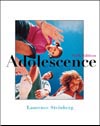Intimacy and autonomy are both important adolescent needs. But they sound as if they are antithetical to one another. Examine several websites that give adolescents advice about handling close personal relationships. How do these two themes play themselves out in this context? Is the same advice given to boys as to girls? About same-sex relationships?
There are lots of places to get advice on dating for kids. Again, remember
that these sites contain a mixture of information from professionals, parents,
and kids. Read critically! How does what you're reading compare to what you've
learned through your textbook and your course?
 |
1 |  | 
According to Sullivan, what is the key developmental task during adolescence? |
|  | A) | Satisfying interpersonal needs. |
|  | B) | Developing a coherent sense of identity. |
|  | C) | Achieving a secure attachment style. |
 |
 |
2 |  | 
According to Sullivan, which of the following is true about the development of intimacy? |
|  | A) | Intimacy develops prior to adolescence and in same-sex relationships. |
|  | B) | Intimacy develops during adolescence and in same-sex relationships. |
|  | C) | Intimacy develops prior to adolescence and in opposite-sex relationships. |
|  | D) | Intimacy develops during adolescence and in opposite-sex relationships. |
 |
 |
3 |  | 
What does research show about the development of identity and intimacy? |
|  | A) | Identity develops before intimacy. |
|  | B) | Intimacy develops before identity. |
|  | C) | Identity and intimacy develop simultaneously during adolescence. |
 |
 |
4 |  | 
Max had a secure attachment relationship with his parents when he was an infant, and now, as an adolescent, he is able to form positive, intimate relationships with others. What concept does this illustrate? |
|  | A) | Secure base model |
|  | B) | Internal working model |
|  | C) | External working model |
 |
 |
5 |  | 
What is the biggest advantage of the Q-Sort procedure? |
|  | A) | It is the least expensive method of collecting data. |
|  | B) | It can be used with participants of all ages. |
|  | C) | It forces raters to give a variety of responses. |
 |
 |
6 |  | 
Which of the following statements best describes the research on American adolescents' intimacy with parents? |
|  | A) | During adolescence, peers become more important sources of intimacy and parents become unimportant. |
|  | B) | A slight drop in intimacy with parents may occur during adolescence, but intimacy with parents usually increases during late adolescence and young adulthood. |
|  | C) | From early adolescence on, teens describe their relationships with parents and peers as equally intimate. |
 |
 |
7 |  | 
What are some functions of close relationships during adolescence? Check all that apply. |
|  | A) | Close friends provide advice and a sounding board for teens to talk about issues of identity. |
|  | B) | Close friendships are positively related to adolescents' mental health. |
|  | C) | Adolescents in close friendships learn about sex and how to deal with members of the opposite sex. |
|  | D) | Close friendships provide a context for sex-role socialization. |
 |
 |
8 |  | 
Who is least likely to begin dating in the next month? |
|  | A) | Anna, a 12-year-old early maturer in a school where girls are expected to start dating at age 14. |
|  | B) | Becky, a 13-year-old late maturer in a school where girls are expected to start dating at age 13. |
|  | C) | Carrie, a 13-year-old early maturer in a school where girls are expected to start dating at age 13. |
 |
 |
9 |  | 
What does research show about sex differences in intimacy? Check all that apply. |
|  | A) | Boys are more likely to mention intimacy as a defining aspect of close friendship. |
|  | B) | Girls are more likely to express greater anxiety over rejection by close friends. |
|  | C) | Girls prefer to maintain exclusive friendships and are less willing to include others. |
|  | D) | Boys' same-sex friendships reach a level of intimacy similar to that of girls' same-sex friendships by middle adolescence. |
|  | E) | Boys and girls report similar levels of actual self-disclosure in close same-sex friendships. |
 |
 |
10 |  | 
Which adolescent will be most negatively affected by her dating patterns? |
|  | A) | Beth, 15, who usually attends parties in a group of mixed-sex friends. |
|  | B) | Angela, 13, who is in a serious exclusive relationship with Brad, 17. |
|  | C) | Stephanie, 14, who does not date at all. |
 |



 2002 McGraw-Hill Higher Education
2002 McGraw-Hill Higher Education